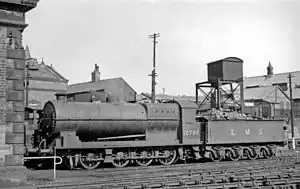L&YR Class 30 (Hughes)
The L&YR Class 30 (Hughes) was a class of 0-8-0 steam locomotives of the Lancashire and Yorkshire Railway. The class was designed by George Hughes and introduced in 1910. Twenty-nine were rebuilds from Aspinall's L&YR Class 30 and 40 were new locomotives.
| L&YR Class 30 (Hughes) | |||||||||||||||||||||||
|---|---|---|---|---|---|---|---|---|---|---|---|---|---|---|---|---|---|---|---|---|---|---|---|
 No. 12782 at Bank Hall Locomotive Depot in 1948 | |||||||||||||||||||||||
| |||||||||||||||||||||||
| |||||||||||||||||||||||
| |||||||||||||||||||||||
| |||||||||||||||||||||||
Numbering
A total of 69 locomotives was produced and these passed to the London, Midland and Scottish Railway (LMS) in 1923. The LMS gave them the power classification 6F and numbered them as follows:
- Rebuilds, 12771-12800
- New locos, 12801-12839
In 1948, British Railways (BR) inherited 11 locomotives and numbered them in the range 52782-52839.[2]
Withdrawal
The first locomotive was withdrawn in 1927 and the last in 1951. None were preserved.
References
- Ian Allan ABC of British Railways Locomotives; part 3 (1948 ed.). p. 44.
- Casserley, H.C.; Johnston, S.W. (1966). Locomotives at the Grouping, no.3, LMS. Ian Allan. p. 129.
This article is issued from Wikipedia. The text is licensed under Creative Commons - Attribution - Sharealike. Additional terms may apply for the media files.